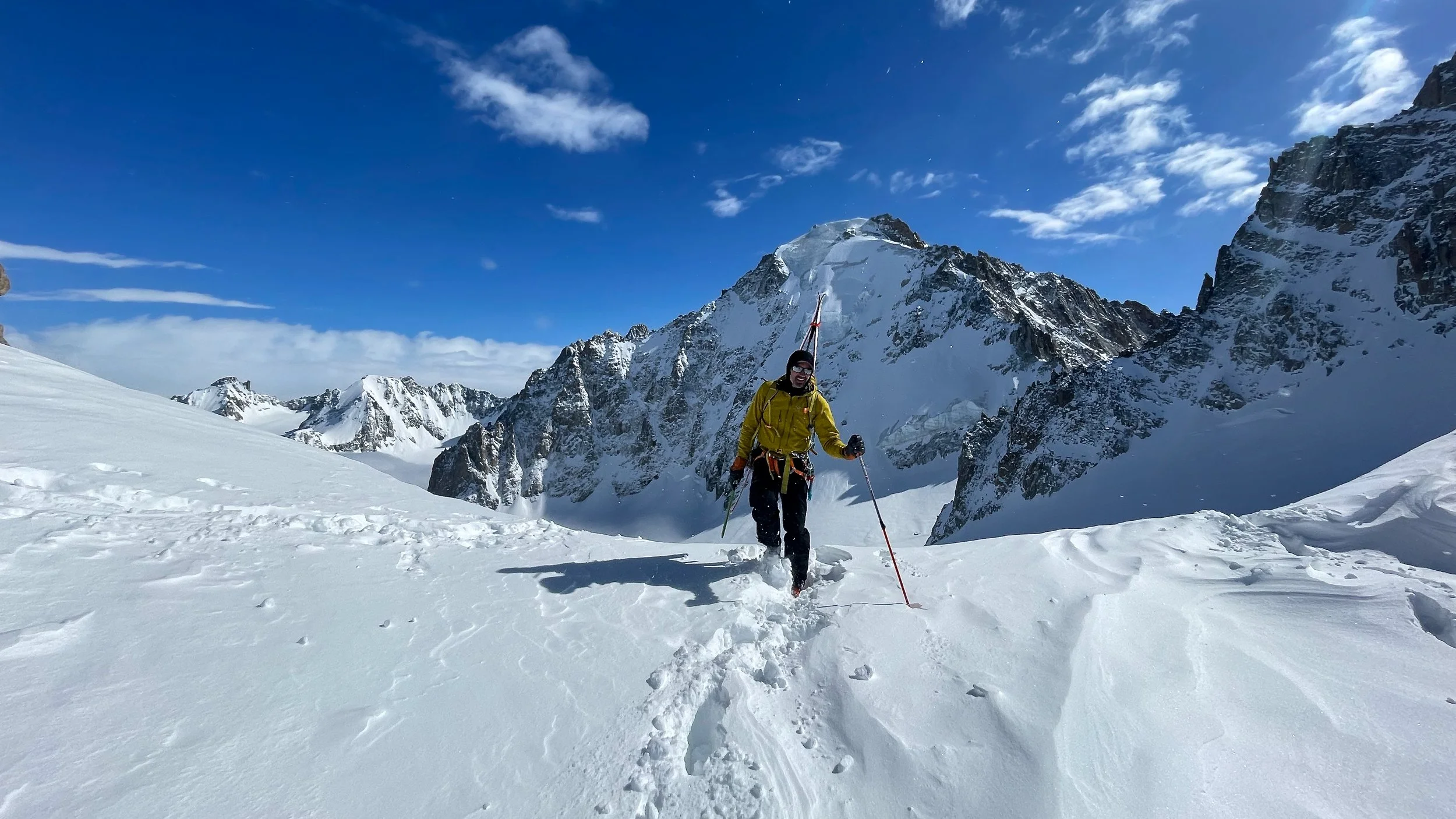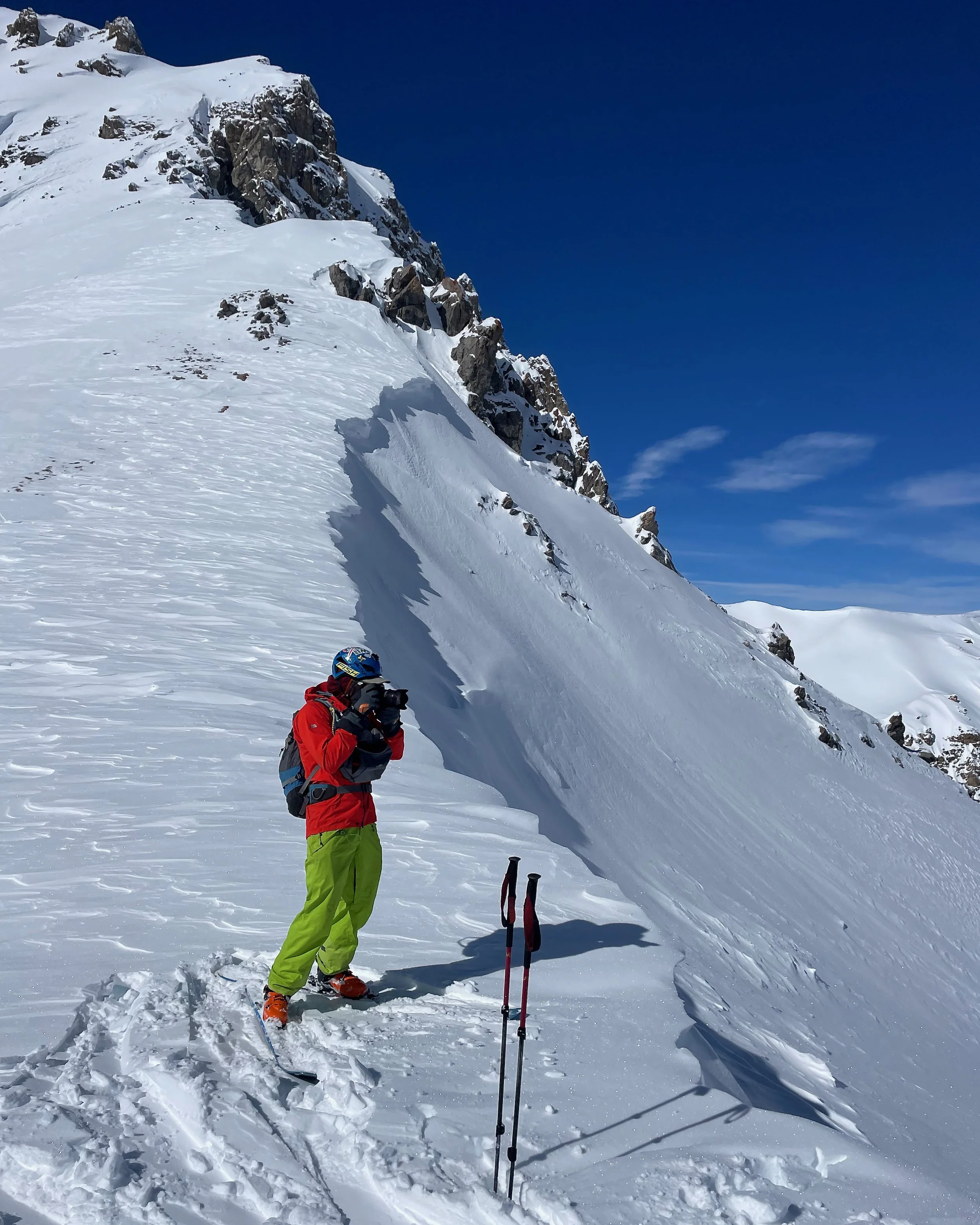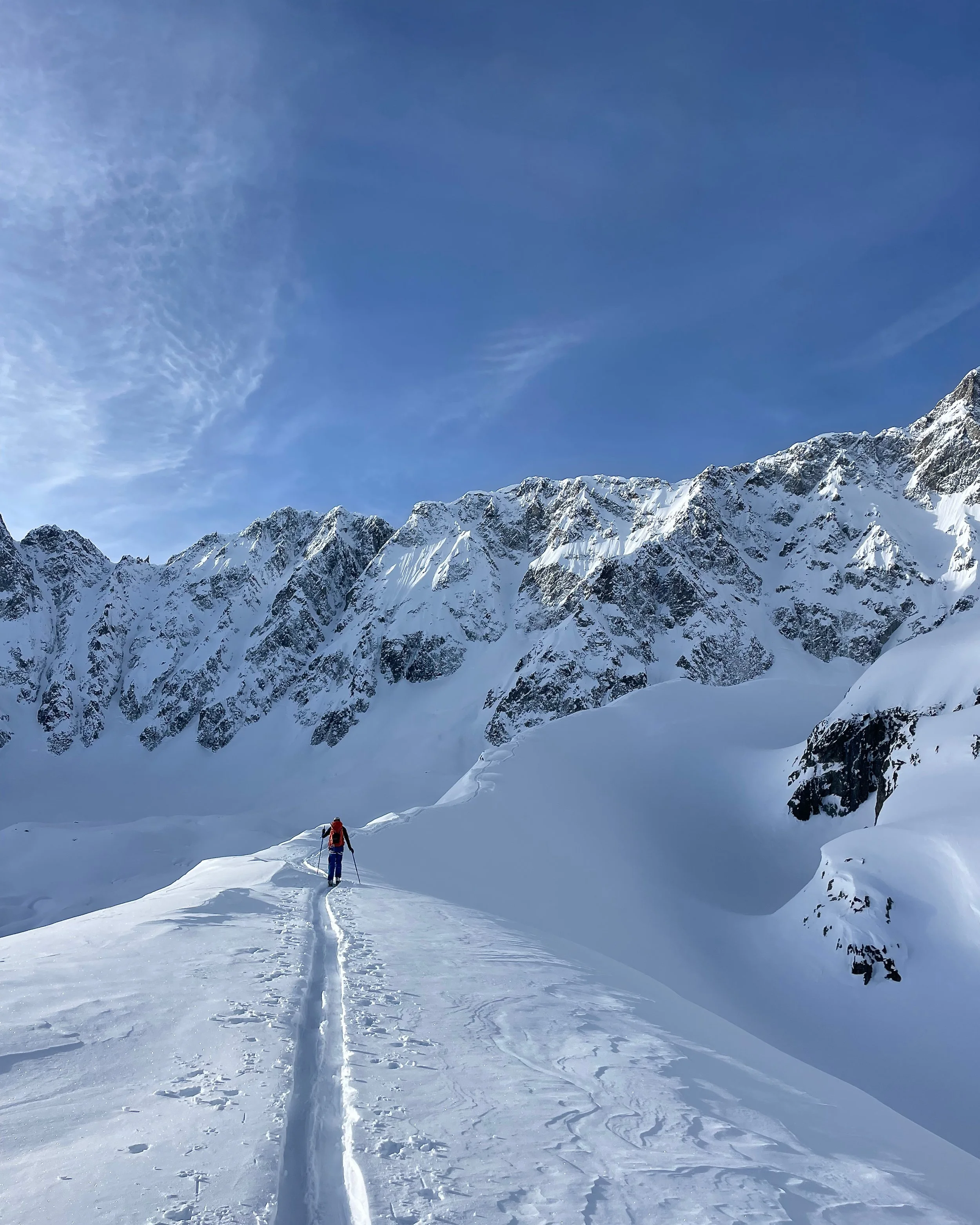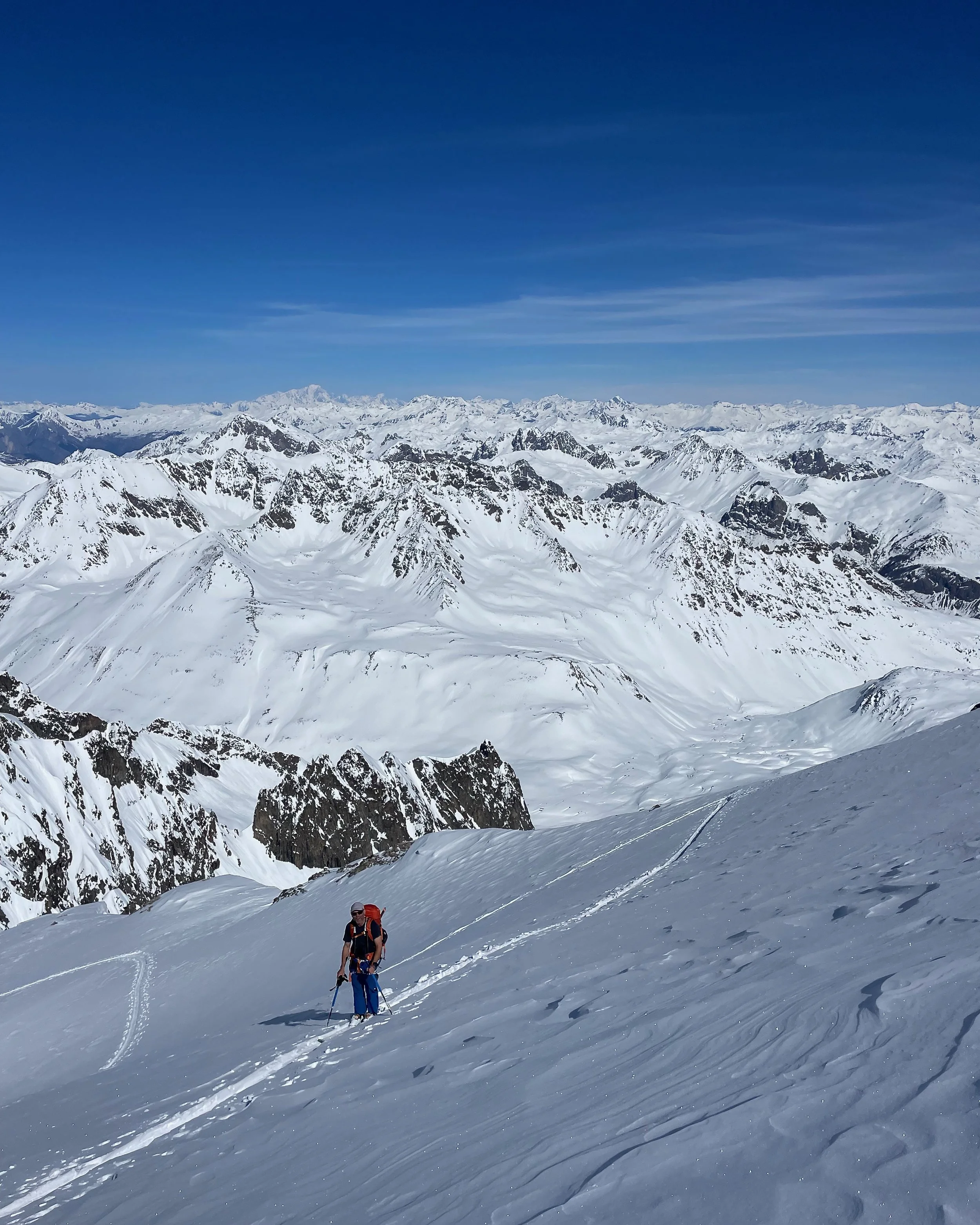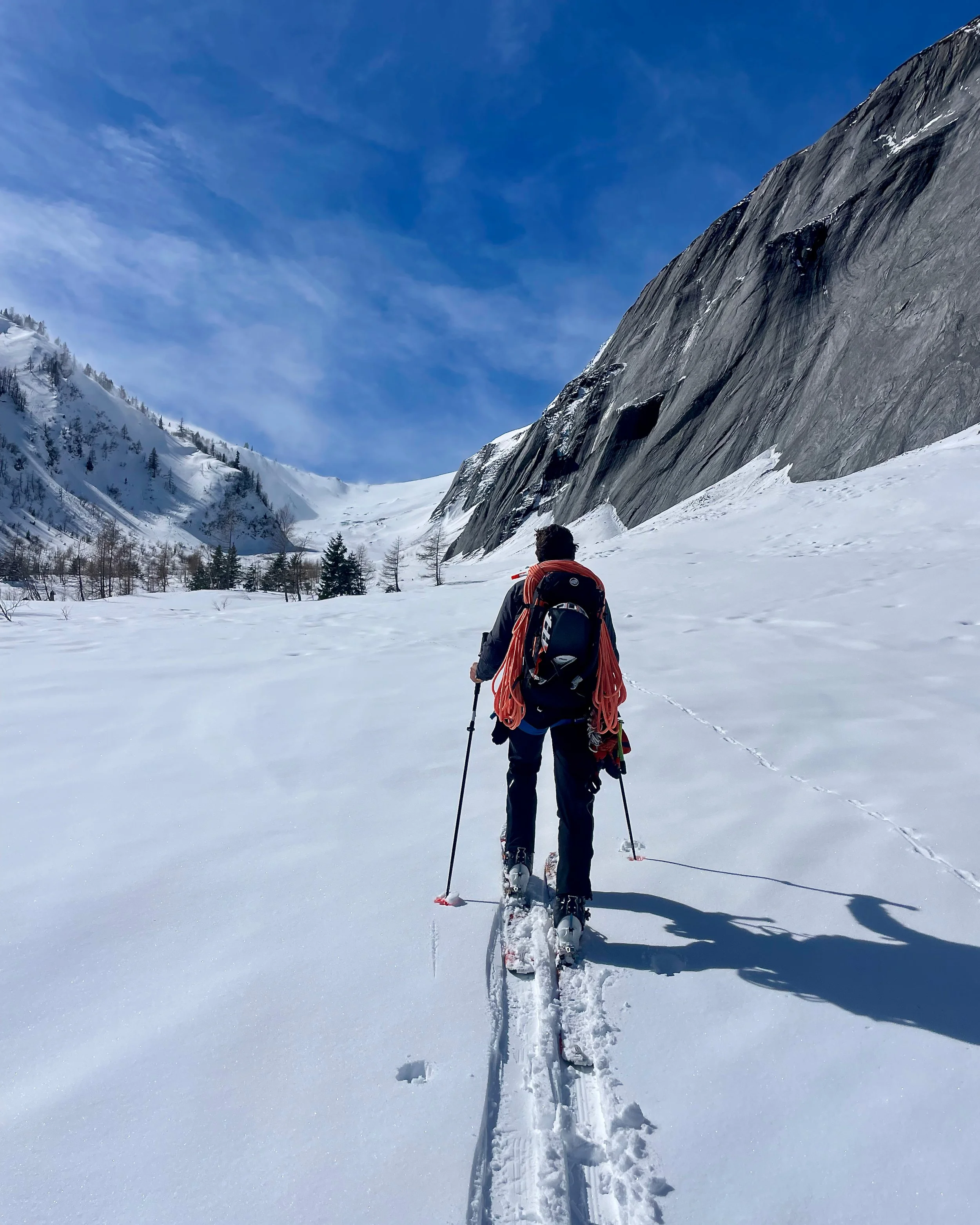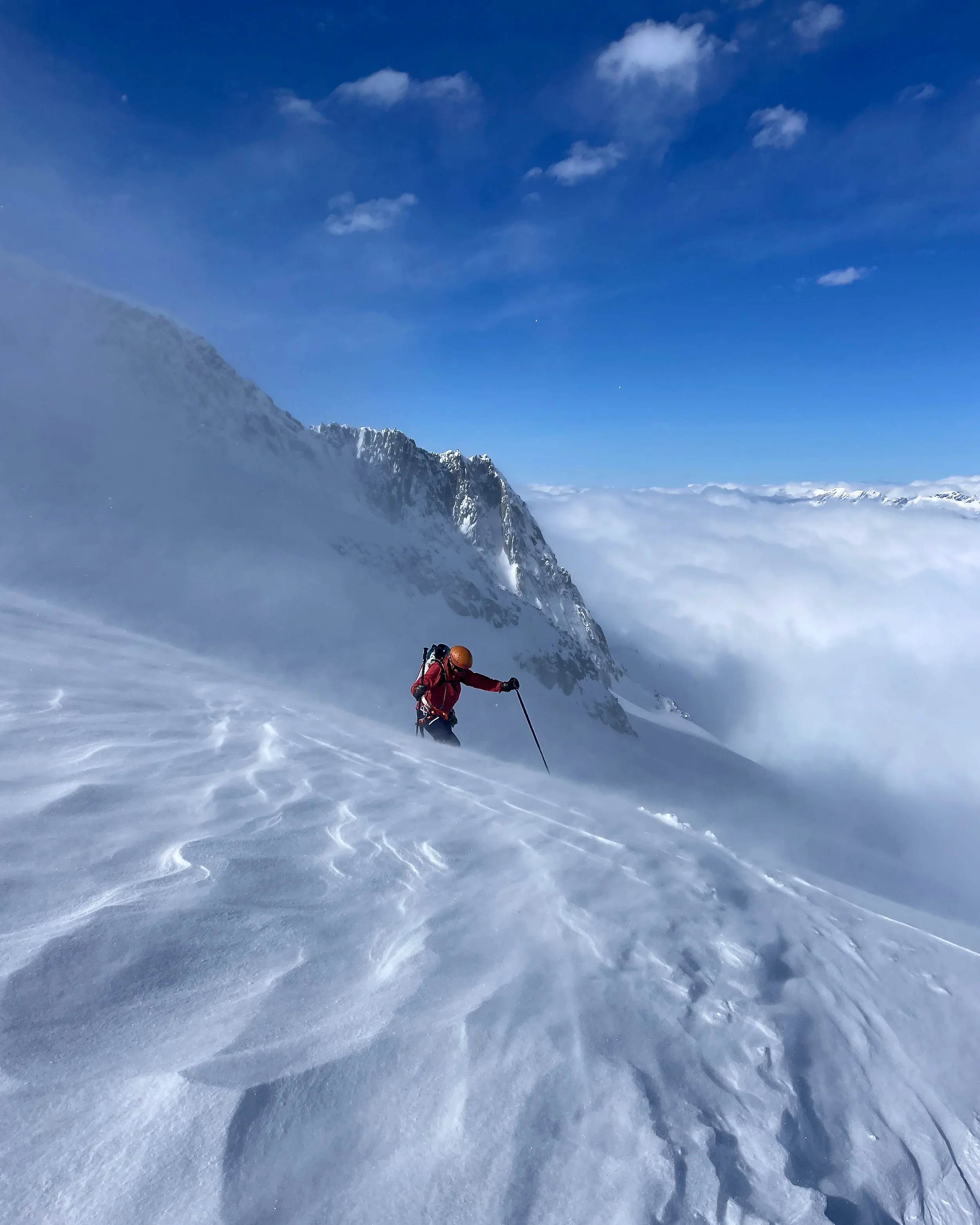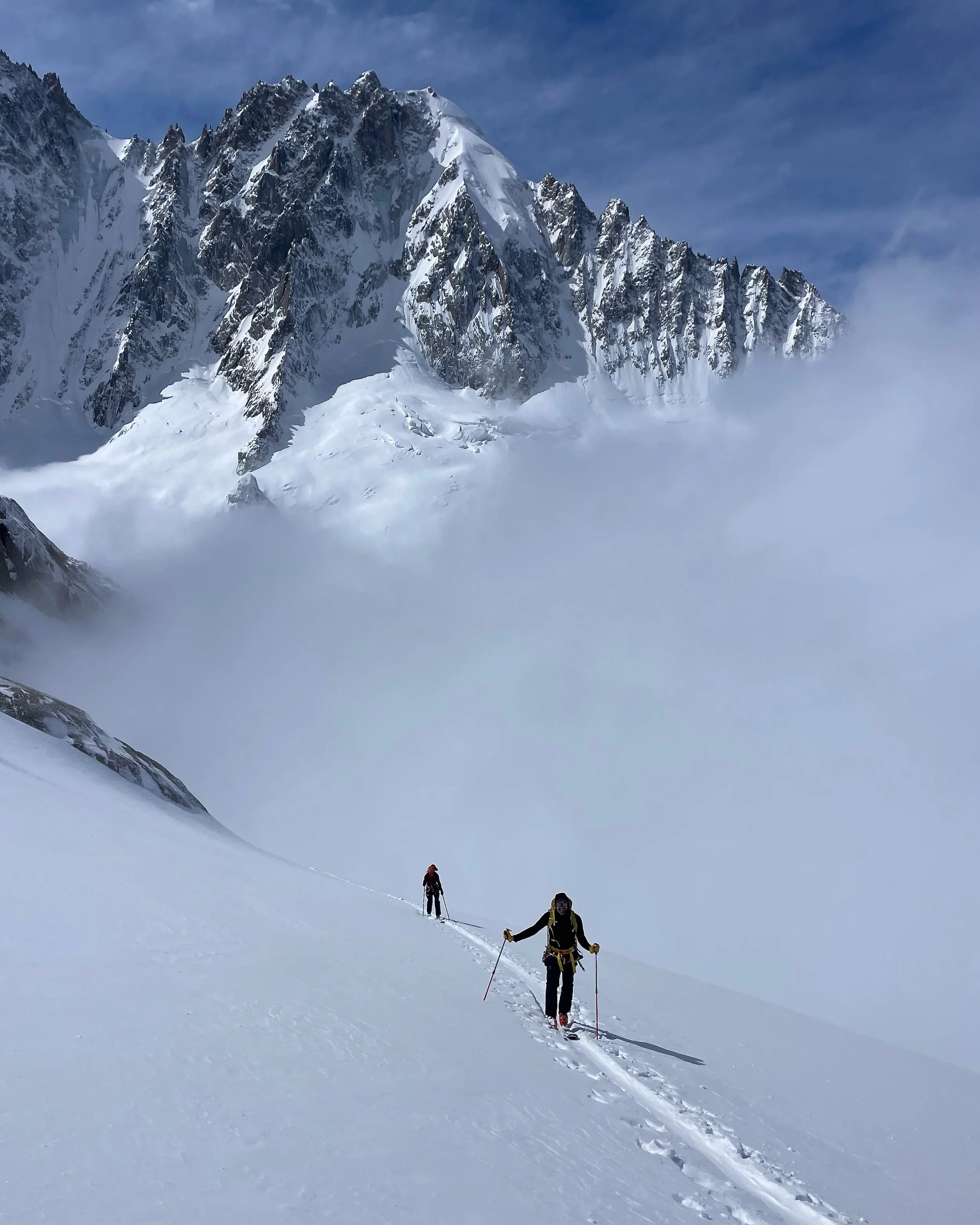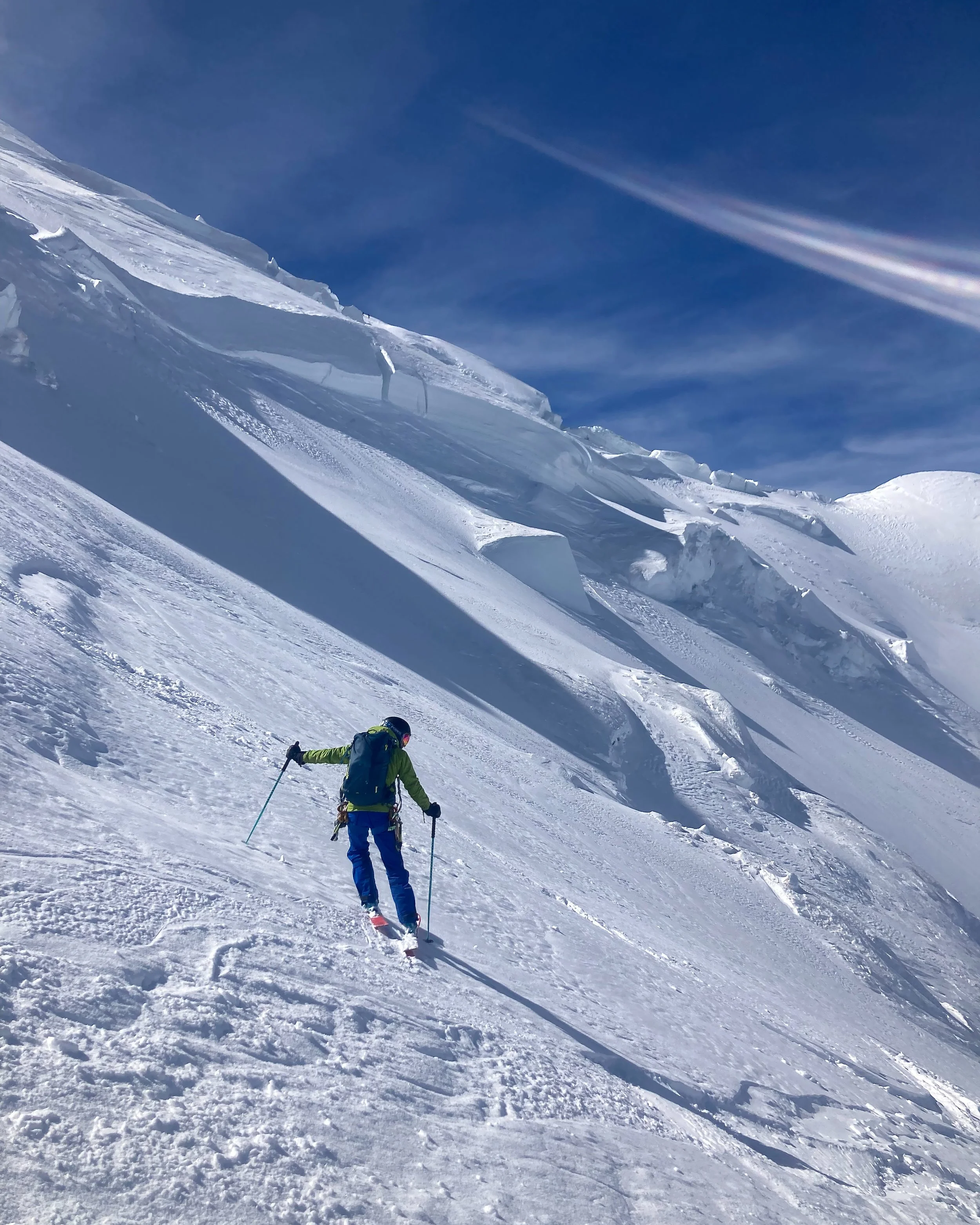Shifting Objectives: Winter Alps 2024
Andy topping out over the Fenêtre du Tour (3414m) before a descent of the Glacier du Tour, Mont Blanc massif.
It was as if the world had stopped. The descent from the Crête de Lenion had been sublime. I somehow existed in a brilliant state of flow, drawing carving powder turns on a blank white canvas, followed by an incredible euphoria of purpose. Something about that experience was deeply meaningful. It was blissfully simple yet was felt at some profoundly primal level. It was to shape forever how I connected with subjective, lived experience. Maslow might have called this self-actualisation. Csikszentmihalyi would have called it a moment of optimal experience. Upon reflection, I would later consider this time a perspective-shifting exploration of intrinsic motivation and our interaction with the natural environment.
It was 11 March, and we had skinned up from Plampinet in the Névache region of the Hautes-Alpes, a small team of wild adventurers looking for a quick hit before the snow became baked in the heat of the morning sun. This was day six of my first week of skiing in the Écrins, the culmination of some brilliant days in the mountains: Tête de Paneyron in Vars, Col du Bal and Crête de Baude in the Hautes-Alpes, Les Jumelles Sud in Le Monêtier-les-Bains, and La Blanche in Vallouise-Pelvoux. I was living one incredible day at a time; my temporary home was a campervan converted in the style of a Finnish sauna (minus an actual sauna), and I was chasing the good snow with whoever would take me with them.
Rob captures each of the team as we drop in from Crête de Lenion (2440m), Névache.
I had driven out to the Alps with a climbing tick list well formed in my mind. Gabarrou-Albinoni on Mont Blanc Du Tacul, Frendo-Ravanel on the Aiguille Carree, and Fil à Plomb on the Rognon du Plan North Face, amongst others. These were winter classics I revered as test pieces. They were to be my preparation for Bolivia and, later, Pakistan. Admittedly, I had given less thought to how and with whom I would climb them; the priority was simply to send them. These routes had taken hold of my mind. I found their historical significance compelling, and the anticipation of how I might feel on these climbs gripped me. I had intrinsically linked my sense of identity and value to attempting these iconic lines. It was time to return to the wild places and tie into the sharp end.
Returning from a trekking trip to Patagonia in early March, and just 24 hours after touching down, I received a message from Dave Palmer. There was a space on a hut-to-hut ski tour in the Queyras. Would I like to join them? I had yet to do any washing from Argentina and Chile, and it would mean heading to Europe a week earlier than planned, but I jumped at the opportunity. I said I would wax my skies and meet the team in Saint-Véran later that weekend.
The camper van was packed, ice tools and crampons sharpened, maps and guidebooks stacked up, and I had messaged everyone I knew in Chamonix who might be a potential climbing partner. I thought a week of ski touring in the Queyras would be a brilliant start to a wonderful winter Alpine adventure. I was right.
These adventures in the Écrins continued with the Couloir Nord of Roch Gauthier, our second outing from Plampinet and a brilliant descent of carving power turns in spring snow under clear blue skies. Uncertainty in the snowpack’s stability in the last 200m of the couloir meant we transitioned from skinning shy of the couloir’s full height. I was quietly grateful for the experience of my two companions.
Dave approaches Brèche de la Plate des Agneaux (3217m) from the Refuge de l'Alpe de Villar d'Arène and the Glacier d'Arsine. The Pic de Neige Cordier (3613m) is still several hours away.
Dave and I had two more days left before other commitments would mean the end of our partnership for the season. We were both keen on a night in a hut, and a two-day ski outing would be the perfect way to end this phase of the adventure. We chose the Crête Nord of Pic de Neige Cordier from the Refuge de l'Alpe de Villar d'Arène, a mix of glacial approach, a steep couloir climb, and a complex descent over remote terrain. We checked the maps, packed a stove, gas, and extra food for two days, and jumped on the road to Villar-d’Arêne in the Hautes-Alpes.
Stepping upwards had become nearly impossible. The snow was too soft to support my weight, and every movement only served to cut away more of the steepening white wall of powder in front of me. We should have left an hour earlier.
Upward progress slowed, and I decided to try again on skis. Just clipping in up here was terrifying enough, and producing consistent kick-turns on ground this steep is challenging. I was taking too long. The early morning air was warming up, and sluffs of wet snow had started sliding down the couloir. I couldn’t see where they were coming from, but I hoped it was the more rapidly warming rocks to my right rather than instability in the upper snowpack. Breathe, assess, and move. Slowly. Eventually, I made it to the col at 3217m, where Dave waited patiently.
We turned left onto the Crête Nord of Pic de Neige Cordier and continued skinning to just below the summit. Bootpacking the final snow slopes brought us to a small, rocky summit. We surveyed the vast expanse of the Écrins massif. La Meije to the northwest, Barre des Écrins to the south, and Montagne des Agneaux to the east. Climbing should never be about a summit, but they are undoubtedly spectacular places. Now came the best part, the reason we had come up here. 1500m of ski descent from Col Émile Pic through the Agneaux and Plate des Agneaux glaciers and back to the Refuge de l'Alpe de Villar d'Arène. I was in awe of the landscape around me. We felt remote on the backside of this mountain, little specks of consciousness moving through a vast theatre of snow, rock, and ice. The snow was challenging, mistakes were consequential, and my legs were exhausted. I was completely present in the moment, acutely aware of my surroundings, feeling the snow beneath my skis and reading the contours of our fragile world as they shifted around me.
Dave skinning up the final snow slopes of Pic de Neige Cordier (3613m).
My time in the Écrins was as wildly enjoyable as it was hugely instructive. I had begun better understanding the factors affecting snow conditions, avalanche risk, and mountain decision-making. I refined what I ate, drank, and packed each day and honed my layering system. Developing these ski touring skills gave me a stronger foundation and increased my confidence for moving through the mountains in winter. I felt well set up for the rest of the trip and had found plenty of potential partners to join me on my tick list of test-piece climbs.
During this time, I became acutely aware that early Alpine trips to Chamonix as a student had shaped me more than I fully appreciated. Those formative years have grown into a love for expedition mountaineering, which has taken me across the Pamirs, Eastern Himalayas, and the Karakoram. Arriving in Argentière later in March after our time in the Écrins felt like coming home. I briefly rested and shook off the nostalgia. It was time to get out skiing again. Given a mixed forecast with precipitation for the morning, I had only planned a short tour for the following day. I wanted to explore the area around La Tour and perhaps drop into Vallorcine, if snow conditions allowed, before hopping on the train back into town.
On 18 March, I awoke at 0630 to the sound of rain lashing down on the van roof. Rechecking the forecast, I saw heavy downpours for the morning and rain below 2200m. It just wasn’t worth it. I felt guilty about missing a day, about not getting out. Perhaps this is the patience and optimisation of time I strive to learn. So instead, I found a café in La Praz, researched my plans for the week, got drawn into several pages of Steve House’s gripping Beyond the Mountain, and sought to find fulfilment in the process of just being. I realised this sense of guilt was being driven almost purely by an extrinsic motivation, an artificial pressure to achieve something, to tick something off. I reminded myself to enjoy this day, for my life had afforded me a great freedom in this opportunity to sit in a warm, cosy café in quiet reflection with excellent coffee.
The weather cleared up over the next few days, and the conditions allowed me to have two brilliant outings in the Argentière basin. The Col du Tour Noir was a superb introduction to Chamonix ski touring. The setting is spectacular, and I was blessed with good company.
Despite these brilliant days on skis, unfortunately, those revered climbs never became a reality. The high snowfall throughout the winter had made accessing these routes near impossible, and the ice on many of them never really fattened up anyway. But conditions allowed for excellent, if selective, ski touring. It was tough to let go of the season I had envisioned for myself, but if I wanted to get out in the mountains, I would have to adapt and become comfortable with redefining the nature and purpose of this trip.
Zander breaking trail from La Fouly as we make our way towards Mont Dolent (3823m) and the Bivouac du Dolent (2667m) for an attempt to climb the Gallet Ridge and ski the south face.
I met Zander for the first time at 0600 in a small parking area off a quiet side street in Les Praz. Planning a two-day outing on a significant Alpine peak with a stranger might be judged as foolhardy by some, but we had spoken several times, and I instantly liked this engaging aspirant mountain guide. Our objective was to climb Mont Dolent (3823m), sitting on the tripoint between France, Switzerland, and Italy, from the picturesque Swiss village of La Fouly, via the Gallet Ridge before a ski descent of the south face.
With skins fixed and carefully packed bags on our backs, we pulled gently up the valley before turning northwards onto the south face of Mont Dolent. As we gained altitude, the terrain steepened, route finding became more complex, and the temperature steadily dropped. Weaving between crevasses and thinking on our feet (or skis), I relished the adventure. The exposure was consequential, but the terrain was never too steep. After several challenging hours, we reached a small bowl perched below the west spur.
‘The bivouac should be right here?’ I exclaimed. We checked the map. I double-checked the GPS. The bivouac should indeed be right beneath our skis. We peered through the descending mist, scanning our little world for any sign of the elusive shelter. Looking away from the face on the edge of our small bowl, I observed a mound of snow that seemed somehow artificial. I skinned up and saw a small corner of orange fibreglass. The bivouac is buried under nearly six feet of snow. We remove our skis and walk around the shelter, searching for a way in. We found the top three inches of the door and began to dig. Twenty minutes later, we had dug out the door and sculpted a fine set of steps. According to the hut logbook, no one had been here since November of the previous year. Hanging up skins and hard shells, we made up two beds of thick red blankets. I throw on a synthetic jacket and join Zander in a hunt for tea bags and gas for the bivouac’s small stove.
A thin slither of light illuminated a crack in the battered door of the small shelter. Snow driven in by gusts of rotor wind had banked up in the entrance of the comical orange capsule. Braving the howling winds and driving snow, Zander stepped outside and managed enough mobile phone signal for an updated weather forecast. Our two-day weather window had closed, and we needed to rethink our plans. Melting snow for another brew, we considered our options. It would be gusting 50 mph on the ridge, visibility would be terrible, and temperatures would be dropping. Moreover, the driving southerly wind had stripped the exposed south face of Mont Dolent of all its snow. This did not make for an appealing 2000m ski descent over complex, occasionally steep, glaciated terrain. A summit attempt the following day seemed simply unjustifiable. Decision made. We would ski out the way we had come up. It was not a mean feat, given the complexity of the snow slopes, poor visibility, and likely challenging snow conditions.
Having already shifted not just the specific objectives of my trip but also its core discipline and purpose, I still had to compromise on my backup plans. But that’s the nature of mountaineering, where weather and conditions often have more of a say in the success of an outing than you do. I found it helpful to move my whole mindset. Instead of focusing on technical progression, I saw the trip as an opportunity for more holistic mountain skills development. I got to know a cohort of like-minded people, improved my mountain decision-making, and refined my skills, techniques, and packing lists.
Zander mid-transition on the west face of the Rinderhorn (3449m) as the conditions come in and force a retreat.
Hoping to dodge the squalls and heavy snowfall forecast for the Chamonix Valley, Zander and I made the short drive to Leukerbad in the canton of Valais in Switzerland. Our first objective in this lively corner of the Bernese Alps was to ski the west face of the Rinderhorn (3449m). Technically straightforward but requiring a range of mountaineering skills, we caught the first lift and set off with minimal faff to maximise our chances in a short weather window. The lift was empty, apart from us two British climbers, which should have told us everything we needed to know.
By mid-morning, we had made half the height gain and skinned into a whiteout. A thick mountain fog had engulfed us, with no more than ten meters of visibility in any direction, and our view of the narrow summit ridge we were aiming for had been obliterated. As the wind picked up, the snow started to fall, and the visibility worsened, we made the call to turn back. We couldn’t see anything as snow and mist swirled violently around us. Precariously balanced on the steepening snow slope, we each stamped out a small platform to quickly rip off our skins and transition to downhill skiing. The descent was surprisingly delightful as we each made a handful of turns before stopping to scout out the next pitch, peering through the bleak mass of grey still surrounding us. Shortly before noon, we dropped out of the weather and reached the small mountain lake of Daubensee, frozen and covered in thick snow. Safely off the mountain, it was time to dig out the baguettes and open the flask of hot tea.
Alena braces as gusts of wind drive spindrift over the Col des Rachasses as we make our way to the Argentière Glacier and the Col du Chardonnet.
A few days later, I was back in Chamonix, where I met Alena and Andy at the Brasserie les Marmottons. We jumped on the Télécabine De Plan Joran and skinned over to the Argentière Glacier via the Col des Rachasses. A superb Alpine adventure followed over cols, glaciers, and small powder bowls, from the Col du Chardonnet to the Glacier de Saleina and on to the Fenêtre du Tour. Finally, we wove our way down the simply outstanding Glacier du Tour and returned to the valley, exhausted but elated.
Andy (front) and Alena skinning over the Glacier des Rognons towards the Argentière Glacier.
I got a message from Paolo on 9 April. Would I like to meet the following evening to discuss skiing Mont Blanc? Absolutely. He has two beds booked in the Refuge des Grands Mulets and is looking for a ski partner. I hadn’t considered skiing the highest peak in Europe, but I would hardly turn down the offer. We discussed the route options and confirmed what gear we each would take.
The following morning, we met at the téléphérique and skin the traverse beneath the Aiguille du Midi to the Refuge des Grands Mulets at just over three thousand meters. A rocky scramble up chains bolted into the granite takes us to the small hut perched atop the triangle of rock, which appears to break through the Glacier des Bossons. It is ideally placed to provide a brief respite for weary mountaineers.
We set off at 3 am in the frigid cold. Skirting beneath a towering wall of seracs, we weave our way up to Col de la Brenva via le Grand Plateau and le Corridor. Occasionally strapping our skies to our packs and bootpacking the steepest sections, a final icy ramp leads to a broad summit ridge. By 10 am, we are sitting with a block of cheese and saucisson sec atop the highest point wholly in Europe. I lie back and draw in the rarefied air, slightly bemused by my decision to finish this trip with a ski tour of Mont Blanc, an objective I hadn’t even considered a few weeks earlier.
The snow begins to soften under a warm winter sun. I adjusted my layers in preparation for nearly two thousand vertical meters of descent in anticipation of variable conditions and tracked out snow. It is time to enjoy my final descent of the season.
Skiing the north face of Mont Blanc (4806m) towards le Grand Plateau on variable snow with nearly two thousand vertical meters of descent.
Reflecting on this experience several months later, in a small base camp tent in the Bolivian Andes, I began to appreciate what this change of mindset had won me. I was fitter and smarter with kit, food, and hydration. I had achieved greater flexibility in perspective and became more comfortable with less. I understood the importance of adaptability, as situations, partners, and conditions are dynamic. In the context of climate change, shifting seasons, and erratic weather, it no longer seems advisable to head to the Alps simply to climb. It is far better to approach winter climbing trips as broader winter Alpine adventures, where the chosen discipline adapts to the available partners and prevailing conditions.
I realise now how privileged I am to have spent time with people who are strangers the one minute and mountain friends the next. I have shared precious moments with those whose lines they have carved through the universe have overlapped and intertwined with my own. The impermanence of shared, if not all, experience has been deeply humbling. There have been glimpses of purpose which have given me great joy and insight. From these experiences of such temporal fragility comes a desire to live as fully present in each moment as possible and to take something of value away from this time, which I’m sure will shape my climbing and mountain adventures for many years.
Chamonix, France & La Paz, Bolivia, March 2024
